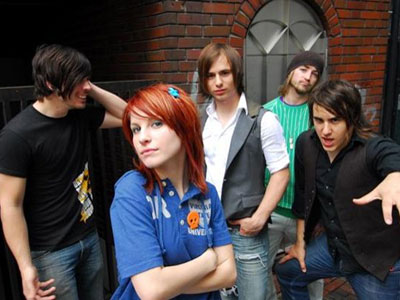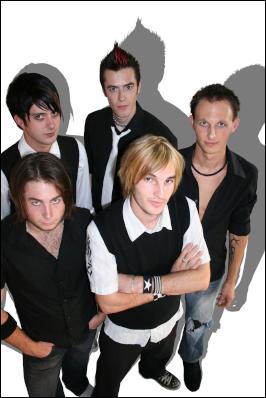 Emo. The dreaded E word. Everybody has heard it, most people have an opinion on it, few people can clearly define it. Whatever you think it means, you can't escape it. Everywhere you go, these days, it seems that the "emo" craze has a firm grip on youth culture. The internet is a stronghold of this and many sub-cultures have been consumed by it. On popular social networking site myspace.com, you don't have to look far to find profiles of teenagers who identfy themselves with the "emo" culture. Bands that have very little to do with each other are lumped into the "emo" category, for better or (often) worse. Any sign of weakness or overdisplay of emotion may be cause you to be branded an emo. Characteristics of followers of either sex include:
Emo. The dreaded E word. Everybody has heard it, most people have an opinion on it, few people can clearly define it. Whatever you think it means, you can't escape it. Everywhere you go, these days, it seems that the "emo" craze has a firm grip on youth culture. The internet is a stronghold of this and many sub-cultures have been consumed by it. On popular social networking site myspace.com, you don't have to look far to find profiles of teenagers who identfy themselves with the "emo" culture. Bands that have very little to do with each other are lumped into the "emo" category, for better or (often) worse. Any sign of weakness or overdisplay of emotion may be cause you to be branded an emo. Characteristics of followers of either sex include:
Fashion
~asymmetrically cut hair dyed black perhaps with brightly colored streaks
~long, fringed bangs covering one side of the face
~form fitting t-shirts, typically of rock bands
~black horn-rimmed glasses
~Chuck Taylor All-Stars, or skate sneakers
~tight jeans
~ornate belt buckles
~studded belts
~tight fitting sweaters
Personality
~sensitive
~shy
~angsty
~depressed
~use of depressing internet screenames accented by straight edge X's, poetic and often cliche slogan try (example: xXAngel_teaRsX_x)
~fixation on and use and of dark and/or death releated imagery
~writing poetry that consists of thems such as depression, confusion, anger, loss, lonlieness, etc.
~sometimes the emo culture is associated with self-harm, such as cutting or burning one's self, as a means of "relieving inner pain"
Where did the "emo" term come from? How has it evolved? What is "truly" emo and what is not? These are some of the questions, I will try to briefly answer.
First Wave: (1985-1994)
 The term emo is short for emotive harcore punk, and is a subgenre of post-hardcore, which is a sub-genre of hardcore, which, in turn is a sub-genre of punk music. Where the term orgininated is a mystery.
The term emo is short for emotive harcore punk, and is a subgenre of post-hardcore, which is a sub-genre of hardcore, which, in turn is a sub-genre of punk music. Where the term orgininated is a mystery.
It is said to have been a term created by emo's detractors, who did not like how emo strayed from harcore's usual topics of politics and rebellion. Guy Picciotto told Flipside Magazine in 1985, that some fans of the band had started using the term emotional hardcore to describe his band's music, which shortened to emo-core, further shortened to emo.
However the word came about, the music behind it all started in the mid-80s D.C., with the 1984 release of Husker Du's Zen Arcade album, which would be a big influence on the emo sound, and with the collaspe of the D.C. region's hardcore scene. Minor Threat had broken up, the violence escalated, with people going to shows just to start fights.
To create a more postive scene, Guy Picciotto formed the Rites of Spring, a band that took the hardcore DIY(do it yourself) effort, yet seperated themselves from the violent scenes by focusing on more personal issues. They are almost universally recognized as the founders of emotional hardcore, with their album, End on End.
Alongside the Rites of Spring, there was Embrace, the band formed by Ian MacKaye of Minor Threat. Bands such as Moss Icon, Dag Nasty, Nation of Ulysses, and Gray Matter were influenced by the sound created by Rites of Spring and Embrace. Unfortunately, many of these bands broke up during the early 90s, thus ending the first wave of emo.
Second Wave: (1994-2000)
 Following the dissolution of Embrace in 1986, Ian MacKaye formed the post-hardcore band, Fugazi, and was soon joined by Guy Picciotto. Though, not usually referred to as emo, Fugazi would be influential to second-wave emo bands such as Sunny Day Real Estate, Braid, and Jimmy Eat World. Perhaps the most important event to come out of the second wave of emo is the 1994 release of Diary by Sunny Day Real Estate. Due to wider promotion of the record than most indie records, the album recieved national attention. As more people learned about the band via the newly formed internet, they were labled emo.
Following the dissolution of Embrace in 1986, Ian MacKaye formed the post-hardcore band, Fugazi, and was soon joined by Guy Picciotto. Though, not usually referred to as emo, Fugazi would be influential to second-wave emo bands such as Sunny Day Real Estate, Braid, and Jimmy Eat World. Perhaps the most important event to come out of the second wave of emo is the 1994 release of Diary by Sunny Day Real Estate. Due to wider promotion of the record than most indie records, the album recieved national attention. As more people learned about the band via the newly formed internet, they were labled emo.
Even though Fugazi were not considered emo, fans of the newer style shifted the term from the hardcore style to the indie. Their justifaction for this was spiltting the genre into two styles: the old harcore form, and the new indie form. In the following years, other bands such as Braid, The Promise Ring, Cap'n Jazz, Christie Front Drive, Mineral and Texas Is The Reason gained major popularity based on their "indie emo" sound. By the late 90s, major labels were looking to sign bands that had this sound, looking to captalize on the popularity of the genre. Many bands resisted, citing loyalty to the independent spirit of emo, or the mistreatment of some bands such as Jawbreaker, as a reason. This inner-conflict led to the dissolution of many indie emo bands, such as Texas Is The Reason.
By the late 90s, the word "emo" began to appear in mainstream circles, even in Teen People magazine, which branded emo the "hip" new music style, and The Promise Ring, a band to watch. Repelled by the mainstream attention, many emo bands shifted their sound, in an attempt to isolate themselves from the scene. By the end of the decade, the indie emo scene had almost completly disappeared.
Third Wave: (2000- the present)
Even though the underground emo scene had nearly disappeared, the term "emo" still floated around, as the mainstream continued to label the few remaining 90s bands such as Jimmy Eat World, "emo".
While Jimmy Eat World had played emo music early in their career, by the time of their 2001 album, Bleed American, they had removed nearly all emo influences. Still, as the mainstream became more aware of the word, and were aware that Jimmy Eat World were connected to it somehow, the band, at their protest, continued to be called emo". Also important was the formation of Dashboard Confessional, by Chris Carrabba, formerly of Further Seems Forever. While earlier emo acts focused on darker and painful topics, Carrabba focused more on love, love lost, and angst. While this newer music was "emotional", it drew far more attention from teenagers.
Major labels looking to captialize on the sucess of Jimmy Eat World and Dashboard Confessional, began seeking out similar bands to sell under the "emo" term.
At the same time, the word emo inexplicably expanded beyond a music genre, to mean strong displays of emotion. Trends and attitudes popular among fans of "emo" bands were labeled "emo", as were the fans. This has led to much confusion, and bands that have nothing in common being labeled emo.
Bands that are NOT emo include: AFI, Aiden, Brand New, Bright Eyes, Coheed and Cambria, Dashboard Confessional, Death Cab for Cutie, Fall Out Boy, From First to Last, Funeral for a Friend, Hawthorne Heights, My Chemical Romance ( are they Emo?), Panic! at the Disco, Taking Back Sunday, Thursday, The Used, and Underoath, etc.
Bands that DO carry on emo's traditional hardcore roots in the modern day include: Circle Takes The Square, A Day In Black and White, City of Caterpillar, Funeral Diner, and Yaphet Kotto.
Screamo, which a faster, more agressive and chaotic form of emo, includes: Saetia, Hot Cross, Orchid, Heroin, etc.
Conclusion: (present-???)
As I hope this article has shown, the history of the word emo is long and varied. With all the confusion and, yes, emotion that surrounds the word, it is hard to tell where it will end up next. As is evident everywhere, the term has been bastardized and turned into a false label, associated with young people who glamorize issues such as death and depression, and a uniformed fasion sense. You can pick an "emo" out of a crowd of people, but you'd be hard pressed pick out a person from a crowd of "emos". There is no such thing as an emo person, and this is all just a passing fad. As with all fads, this one will die out. But seeing as it has survived hardcore, indie, and Teen People, emo will not die out with it. But be reborn again.

